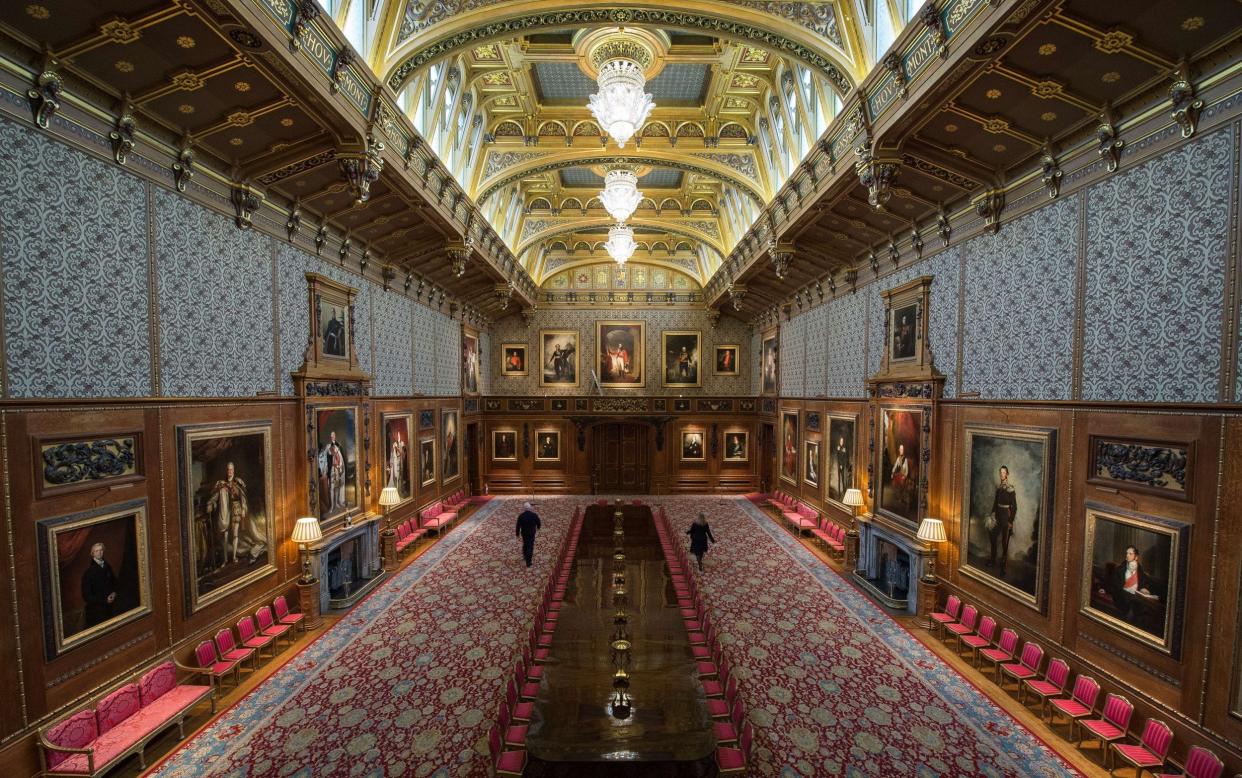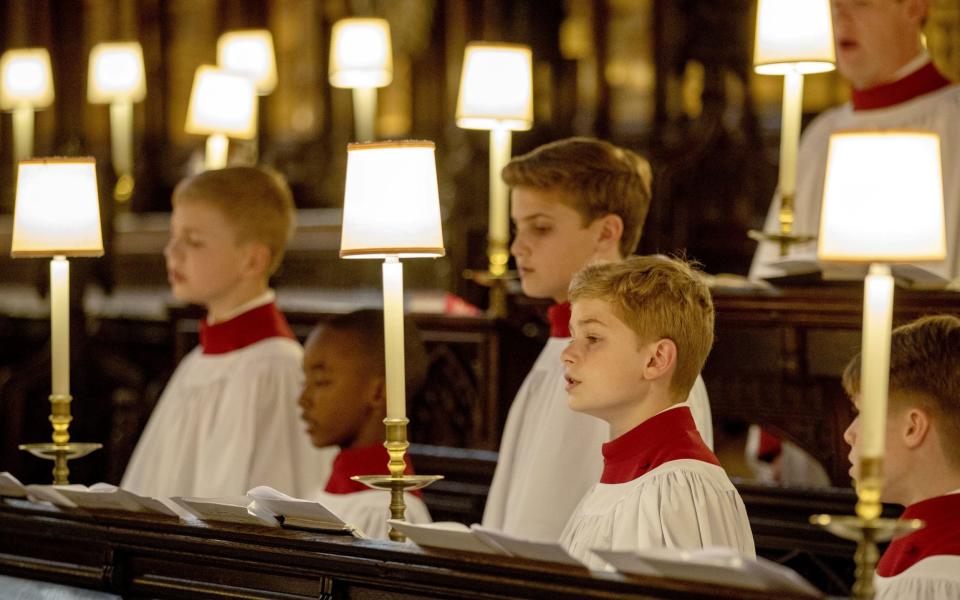10 facts you probably didn't know about Windsor Castle

After the magnificent pomp of her funeral, Queen Elizabeth II now lies at rest with her husband and close family in the tiniest royal annexe imaginable.
Windsor Castle, always ‘home’ to the late Queen, reopened to the public today (September 29) and it remains to be seen how its glorious medieval foundation, His Majesty’s Free Chapel of St George, will deal with the volume of visitors wanting to see her modest resting place. Long queues were reported this morning.
The Chapel itself is large. It dominates the Lower Ward and is central to the castle’s ceremonial life, but it is a separate entity: autonomous spiritual home to the College of St George and the Most Noble Order of the Garter (Britain’s oldest chivalric order, founded in 1348).
This version of the Chapel was completed during the reign of Henry VIII, who also has a simple burial here, with a ledger stone in the nave and a vault below shared with Queen Jane (Seymour) and the beheaded King Charles I. It has a stunning fan-vaulted ceiling studded with Tudor imagery, a Quire blazing with current Knights’ heraldic banners and 800 years’ worth of former Knights’ stall plates, the tombs of numerous monarchs and an east window dating to 1506.
The late Queen’s burial place was created for her father, George VI. It is tucked into a space near the transept not more than a few feet across and is always hard to peer into without blocking the passage of visitors behind you. He was joined there by his wife, the late Queen Mother, and his second daughter, Princess Margaret, both of whom died almost exactly 50 years after him in 2002.

Last week, Buckingham Palace released images of the new ledger stone shared by George VI and the Queen Mother and the Queen and Prince Philip, with a central Garter star. Next to it the free-standing stone of Princess Margaret, a rare example of a royal cremation, leans against the wall. They are just yards from the tomb of King Edward IV, who began St George’s Chapel in 1475.
The Queen’s committal procession and service took place on September 19, but there is no standing by her tomb to contemplate or pray, partly because there is simply no room for public entry and partly because, like her parents, she has no grand tomb, just the simplest of ledger stones. Instead, visitors must file past and make do with a quick nod of respect. No fuss. No bother. Surely exactly what she would have wanted.
Here are 10 fascinating things you probably didn't know about Windsor Castle.
1. The finest view
The best view in the Castle only appeared after its most recent refurbishment. The State Apartments now provide a fabulous vista of the 2.6-mile Long Walk in Windsor Great Park, starting at the Castle and ending at a speck on the horizon which is in fact a famous equestrian statue of King George III known as the Copper Horse. The Long Walk, flanked by dazzling grass and avenues of oak, chestnut and London plane trees, became world famous when Harry and Meghan bowled down it in their wedding carriage, between rows of cheering crowds. Even without a royal landau it makes an excellent post-Castle walk.

2. Thomas Howard’s Garter Plate
In St George’s Chapel, look in the South Quire Aisle for a Garter Plate – a rectangular brass plaque, about six inches tall – fastened in splendid isolation to the inner wall. When a Knight of the Garter dies, their Stall or Garter Plate is fixed to the panelling in the Garter Chapel. This one belonged to Thomas Howard, fourth Duke of Norfolk, executed for treason in 1572. His plate, flung out of the Chapel, was returned in a ceremony in 1955, and his descendant, the 18th Duke, who also holds the hereditary title of Earl Marshal, organised the late Queen’s funeral and will organise the new King's coronation.
3. The crowning glory
Windsor Castle is unusual for a Norman castle in that it has three baileys, or enclosed spaces, in this case known as Upper, Middle and Lower Ward. These protect a central keep called the Round Tower (not quite round and now home to the Royal Archives). The keep sits on a chalk mound or motte, today covered in perfectly mown grass, and there’s a line visible around 25 feet from the top. This is an extra bit, added by King George IV’s architect Sir Jeffry Wyatville, to heighten the tower and improve the Castle’s profile from a distance.

4. A snappy door handle
In St George’s Chapel, on the other side of the nave from the Queen’s resting place, look for the peaceful Bray Chantry Chapel. Entrance is only for people who wish to pray, but look at the door handle, which resembles a set of crocodile teeth. This is the personal badge, or rebus, of Sir Reginald Bray, who posthumously paid for the completion of the Chapel. In return he was rewarded with no less than 175 versions of his badge, in different materials, representing a hemp bray, a crude tool used to break down the fibres of the hemp plant.
5. A surprisingly venerable ceiling
At last Windsor Castle has a restaurant, the Undercroft Cafe, which opened in 2020 to supply hungry visitors. As you tackle your Victoria sponge or ice cream made with milk from the royal herd, look up. The polygonal stone columns splaying out to form an elegantly vaulted roof are not far off 800 years old, for this is the 14th-century undercroft, or basement storage, built by King Edward III, who also founded the Order of the Garter.

6. The hidden pantos
Visit the Waterloo Chamber, designed to celebrate the Duke of Wellington’s victory over Napoleon’s forces in 1815, and Sir Thomas Lawrence’s grand portraits of be-ribboned and short-jacketed European leaders who supported the cause stare haughtily down at you. In 2020, when the Castle reopened after Covid, the Lawrence portraits were being restored and behind them temporarily revealed 16 vivid ‘Pantomime paintings’ by a young evacuee called Claude Whatham. The name refers to the Princesses Elizabeth and Margaret enthusiastically acting in wartime pantos at the Castle. The paintings are now hidden again.
7. The thousandth Garter Knight
St George’s Hall is a magnificent piece of contemporary Gothic architecture, designed in green oak by Giles Downes of Siddell Architects, who faced the daunting task of replacing the 1830s timber hall that burned in the fire of 1992, the late Queen’s ‘annus horribilis’. It’s used for state banquets and both the King and the Queen Consort and Harry and Meghan had wedding receptions here. Look at the heraldic badges in the window embrasures and you will see little numbers above them. No 1,000 belongs to His Royal Highness Prince William of Wales, invested as the thousandth Garter Knight by his grandmother in 2008.

8. A close-up of the guards
You will never get nearer to the Changing of the Guard than you do at Windsor. A small group of guards marches smartly from Upper to Lower Ward before the ceremony begins and there is much satisfying shouting and an inspection before the Old Guard disappears into the barrack room behind. If you can’t get in on time, wait on the High Street by 10.45 for the New Guard to file past from Victoria Barracks into the Henry VIII Gate.

9. The Banquet of the Gods
Windsor has been rebuilt and its interiors redesigned ever since it was first constructed in the 1100s. The flamboyant George IV did a sweeping refurb, getting Sir Jeffry Wyatville to plaster over some of the superb ceiling frescoes painted by Antonio Verrio for Charles I in the 1680s. There are three survivors, one of the most fun being The Banquet of the Gods in the King’s Dining Room: children love spotting the dazzling peacock whose tail sweeps right out of the trompe-l’oeil frame and charming Grinling Gibbons limewood carvings feature fish, fowl, fruit and flowers. It will certainly make you feel like paying a visit to the Undercroft Cafe.

10. Evensong services
Perhaps the best way to remember the late Queen, whose steady faith has been much in the news since her death, is to attend a service at St George’s Chapel. Evensong is at 5.15pm and is sung by the Chapel Choir, founded at the same time as the Order of the Garter. The choristers are from St George’s School and some the adult singers or Lay Clerks live with their families in the 15th-century Horseshoe Cloister facing the West Door. It’s cheering to see the odd football or frisbee peeking out of such venerable surroundings.

How to visit Windsor Castle
Windsor Castle opens 10am to 5.15 pm from March 1 to October 31 and 10am to 4.15pm from November 1 to February 28. The Semi-State Rooms open November 3 2022 to March 26 2023 (not if the State Apartments are closed). The Castle itself is closed on Tuesdays and Wednesdays.
Tickets cost from £26.50 adults, £17.50 for young people aged 18 to 24, £14.50 for children aged 5 to 17 and people with disabilities, under fives go free. Prices are higher on Saturdays.
Tips for making the most of your visit
If possible, leave your visit a month or two until the Castle and Chapel have settled down – judging by Westminster Abbey, for example, immediate interest (and queues) will be huge.
Check that the parts of the Castle that you wish to see are open – for example, the State and Semi-State Rooms close during State visits and the Guard Change does not take place daily.
St George’s Chapel is open only for worship on Sundays – there is no sightseeing.
If you’re not worried about seeing the Changing of the Guard, aim for the quiet time during or just after lunch, when the morning rush is over and the afternoon dash has not begun.
It’s crucial to check the website before you go: rct.uk. See also the best hotels in Windsor for ideas on where to stay.


